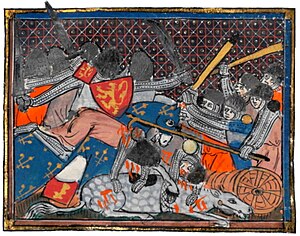Battle of the Golden Spurs
| Battle of the Golden Spurs | |||||||
|---|---|---|---|---|---|---|---|
| Part of the Franco-Flemish War | |||||||
 Illustration of the Battle of Courtrai from the 14th century |
|||||||
|
|||||||
| Belligerents | |||||||
|
|
|
||||||
| Commanders and leaders | |||||||
|
Pieter de Coninck Jan Borluut Jan van Renesse |
|
||||||
| Strength | |||||||
| 9,000 men-at-arms 400 nobles |
1,000 Pikemen 1,000 Crossbowmen 3,500 infantry 2,500 nobles & knights |
||||||
| Casualties and losses | |||||||
| c.100 | c.1,000~ | ||||||
The Battle of the Golden Spurs (Dutch: Guldensporenslag, French: Bataille des éperons d'or), also known as the Battle of Courtrai, was a battle fought between the Kingdom of France and the County of Flanders at Kortrijk (Courtrai in French) in modern-day Belgium on 11 July 1302.
In 1302, after several years of unrest, the people of Flanders revolted against French rule and massacred many Frenchmen in the Flemish city of Bruges. King Philip IV of France immediately organized an expedition under Count Robert II of Artois to put down the rebellion. Meanwhile, the civic militias of several Flemish cities were assembled to counter the expected French attack.
When the two armies met outside the city of Kortrijk, the mounted French knights proved unable to defeat the well-trained Flemish foot militia on a battlefield particularly unsuited for cavalry. The result was a rout of the French nobles, who suffered heavy losses at the hands of the Flemish. The battle was a famous early example of an all-infantry army overcoming an army that depended on the shock attacks of mounted knights.
During the 19th and 20th centuries, the Battle of the Golden Spurs became an important cultural reference point for the Flemish Movement. In 1973, the date of the battle was chosen to be the date of the official holiday of the Flemish Community in Belgium.
The origins of the Franco-Flemish War (1297–1305) can be traced back to the accession of Philip IV "the Fair" to the French throne in 1285. Philip hoped to reassert control over the County of Flanders, a semi-independent polity notionally part of the Kingdom of France, and possibly even to annex it into the crown lands of France. In the 1290s, Philip attempted to gain support from the Flemish aristocracy and succeeded in winning the allegiance of some local notables, including John of Avesnes. He was opposed by a faction led by the Flemish knight Guy of Dampierre who attempted to form a marriage alliance with the English against Philip. In Flanders, however, many of the cities were split into factions known as the "Lilies" (Leliaerts), who were pro-French, and the "Claws" (Clauwaerts), led by Pieter de Coninck in Bruges, who advocated independence.
...
Wikipedia
